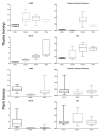NMR Metabolite Profiling in the Quality and Authentication Assessment of Greek Honey-Exploitation of STOCSY for Markers Identification
- PMID: 36140981
- PMCID: PMC9498239
- DOI: 10.3390/foods11182853
NMR Metabolite Profiling in the Quality and Authentication Assessment of Greek Honey-Exploitation of STOCSY for Markers Identification
Abstract
Honey is a natural, healthy commodity and is probably among the most complex foods produced by nature. It is the oldest recorded and certainly the only natural sweetener that can be used by humans without any further processing. Nowadays, the increase in honey's value, along with its growing list of healthy attributes, has made the present raw material a prime target for adulteration. In the current study, NMR-based metabolite profiling in combination with chemometrics was applied in the quality control of Greek honeys from northeastern Aegean islands. Moreover, statistical total correlation spectroscopy (STOCSY) was employed for the first time as a dereplication and structural elucidation tool in the honey biomarker identification process. A total of 10 compounds were successfully identified in honey total extracts via 1H NMR spectroscopy. Compounds such as 5-(hydroxymethyl)furfural, methyl syringate, a mono-substituted glycerol derivative and 3-hydroxy-4-phenyl-2-butanone, among others, were identified as potential biomarkers related to the botanical and geographical origin of the samples. High-Resolution Mass Spectrometry (HRMS) was used as an additional verification tool on the identified compounds.
Keywords: Greek honey; NMR profiling; STOCSY; biomarkers; botanical origin; geographical origin.
Conflict of interest statement
The authors declare no conflict of interest.
Figures





Similar articles
-
NMR-Based Metabolite Profiling and the Application of STOCSY toward the Quality and Authentication Assessment of European EVOOs.Molecules. 2023 Feb 11;28(4):1738. doi: 10.3390/molecules28041738. Molecules. 2023. PMID: 36838725 Free PMC article.
-
Geographical Origin Discrimination of Monofloral Honeys by Direct Analysis in Real Time Ionization-High Resolution Mass Spectrometry (DART-HRMS).Foods. 2020 Sep 1;9(9):1205. doi: 10.3390/foods9091205. Foods. 2020. PMID: 32882806 Free PMC article.
-
The Use of SPME-GC-MS IR and Raman Techniques for Botanical and Geographical Authentication and Detection of Adulteration of Honey.Foods. 2021 Jul 20;10(7):1671. doi: 10.3390/foods10071671. Foods. 2021. PMID: 34359541 Free PMC article. Review.
-
[Analysis of differences between unifloral honeys from different botanical origins based on non-targeted metabolomics by ultra-high performance liquid chromatography-quadrupole time-of-flight mass spectrometry].Se Pu. 2021 Mar;39(3):291-300. doi: 10.3724/SP.J.1123.2020.06029. Se Pu. 2021. PMID: 34227310 Free PMC article. Chinese.
-
Geographical Origin Authentication-A Mandatory Step in the Efficient Involvement of Honey in Medical Treatment.Foods. 2024 Feb 9;13(4):532. doi: 10.3390/foods13040532. Foods. 2024. PMID: 38397509 Free PMC article. Review.
Cited by
-
Elemental Fingerprinting Combined with Machine Learning Techniques as a Powerful Tool for Geographical Discrimination of Honeys from Nearby Regions.Foods. 2024 Jan 12;13(2):243. doi: 10.3390/foods13020243. Foods. 2024. PMID: 38254544 Free PMC article.
-
Insight into the Recent Application of Chemometrics in Quality Analysis and Characterization of Bee Honey during Processing and Storage.Foods. 2023 Jan 19;12(3):473. doi: 10.3390/foods12030473. Foods. 2023. PMID: 36766000 Free PMC article. Review.
-
NMR-Based Metabolite Profiling and the Application of STOCSY toward the Quality and Authentication Assessment of European EVOOs.Molecules. 2023 Feb 11;28(4):1738. doi: 10.3390/molecules28041738. Molecules. 2023. PMID: 36838725 Free PMC article.
References
-
- Se K.W., Wahab R.A., Syed Yaacob S.N., Ghoshal S.K. Detection Techniques for Adulterants in Honey: Challenges and Recent Trends. J. Food Compos. Anal. 2019;80:16–32. doi: 10.1016/j.jfca.2019.04.001. - DOI
-
- Camina J.M., Pellerano R.G., Marchevsky E.J. Geographical and Botanical Classification of Honeys and Apicultural Products by Chemometric Methods. A Review. Curr. Anal. Chem. 2012;8:408–425. doi: 10.2174/157341112801264923. - DOI
-
- Ohmenhaeuser M., Monakhova Y.B., Kuballa T., Lachenmeier D.W. Qualitative and Quantitative Control of Honeys Using NMR Spectroscopy and Chemometrics. ISRN Anal. Chem. 2013;2013:825318. doi: 10.1155/2013/825318. - DOI
Grants and funding
LinkOut - more resources
Full Text Sources

